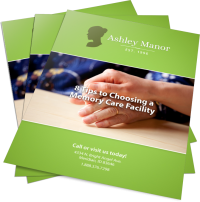When Is It Time to Make A Move.
When it’s no longer safe or healthy for a parent to be at home. If your parent becomes more susceptible to falls, poor nutrition, forgets to take medication, etc., it might be time to make a change for the good and welfare of the one you love.
What Can I do to Prepare for This Difficult Change?
Information is everything. Take advantage of resources through agencies like the Alzheimer’s Association that offers guidance on support services for those stricken by the disease and those who care for them. Begin a search that is the perfect fit for you loved one, specifically. Get legal papers in order in case you need to exercise power of attorney to make decisions that are in the best interest of a relative. Finally, consult a physician for medical advice on the disease and how to make the move less traumatic.
What Do I Do If My Parent Doesn’t Want to Move?
Adult-children who move an unwilling parent into a facility suffer guilt. Conversely the parent feels a loss of their independence and control over their life. There is a sense of helplessness. Care-givers can lessen the emotional pain of these realities by first gaining an understanding of what the parent is experiencing. Change is always scary. When change is involuntary, it’s even more so. For that reason, it is always important to speak with your loved one and allow them to play an active role in the process of moving.
A visit to a potential facility is a good starting point. Many times, it’s possible to recruit residents to meet and greet visitors to make them feel at ease about the transition. Another approach is to talk with your parent and clarify that the move may only be temporary. It’s a matter of practicality. God, every child hates lying to a parent. But setting the ego aside, there is a peace in knowing the parent who watched over you will now receive the care they require in a residential facility. That includes daily assistance with basic tasks, medical care and activities that provide stimulation to confront the disease.
How Can I Make the Transition Easier?
One of the common suggestions is to make the move as quickly and uneventful as you can. Another important task is to make the new home a reflection of the old one in as many ways possible. Photos, furniture, even the size of the room if of similar dimensions will be of comfort to the new resident who will be surrounded by their possessions that makes the new place feel like a familiar one. Just as important are the sounds and smells that remind one of home – favorite movies, music and scents can all work to calm a new resident. Combining the environment with socially rich activities help the new patient embrace the change.
And…Listen.
Stay positive, listen closely and work to make the best decisions on behalf of the parent who needs you to guide them. Take an opportunity to allow care givers to provide you with a tour of the facility and show that with this transition there is an opportunity make the present as meaningful as the past.



Leave a Reply